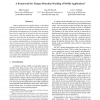33 search results - page 4 / 7 » N-Gram-Based Detection of New Malicious Code |
IACR
2011
12 years 6 months ago
2011
Norway is going to experience an Internet voting scheme in September 2011 for local governmental elections, targeting a comprehensive Internet voting system in 2017 for national el...
ISSRE
2003
IEEE
13 years 12 months ago
2003
IEEE
Today’s applications are highly mobile; we download software from the Internet, machine executable code arrives attached to electronic mail, and Java applets increase the functi...
SP
2007
IEEE
14 years 29 days ago
2007
IEEE
The integrity of kernel code and data is fundamental to the integrity of the computer system. Tampering with the kernel data is an attractive venue for rootkit writers since malic...
SP
2006
IEEE
14 years 21 days ago
2006
IEEE
Attackers and defenders of computer systems both strive to gain complete control over the system. To maximize their control, both attackers and defenders have migrated to low-leve...
ACSC
2006
IEEE
14 years 23 days ago
2006
IEEE
Code obfuscation is a relatively new technique of software protection and it works by deterring reverse engineering attempts by malicious users of software. The objective of obfus...

